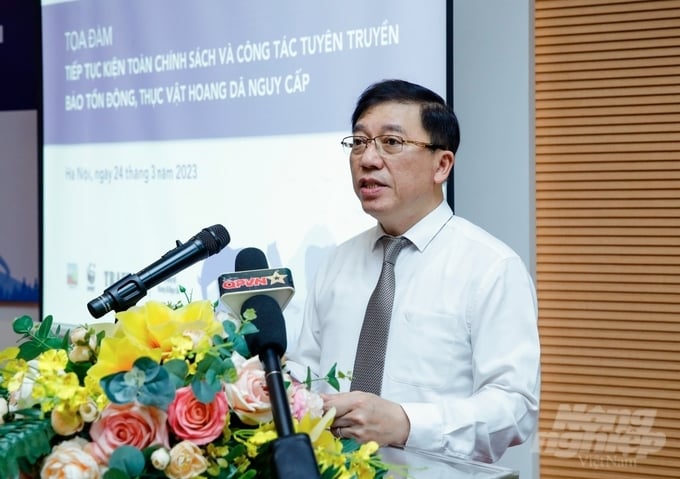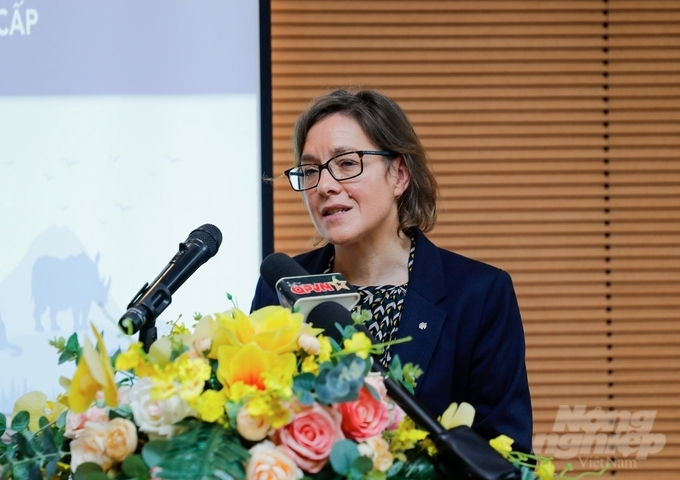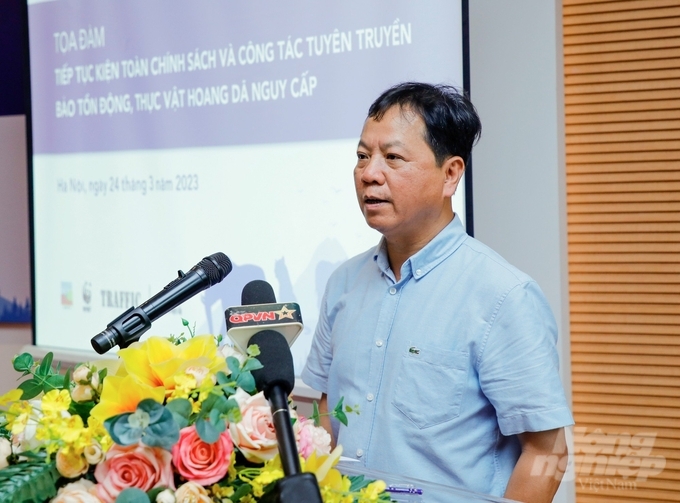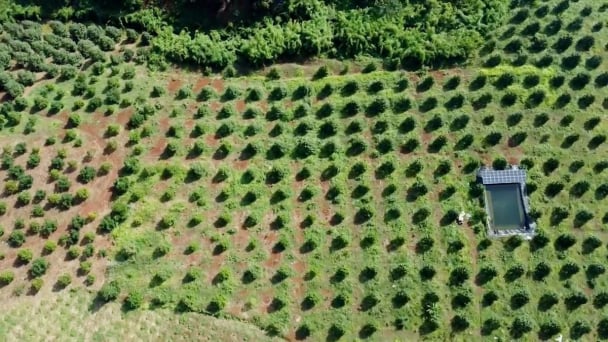May 30, 2025 | 18:07 GMT +7
May 30, 2025 | 18:07 GMT +7
Hotline: 0913.378.918
May 30, 2025 | 18:07 GMT +7
Hotline: 0913.378.918

Mr. Nguyen Tuan Anh, Standing Deputy Head of the Delegate Affairs Committee, making a speech at the high-level seminar with the National Assembly of Vietnam on consolidating policies and propaganda for the conservation of endangered wildlife. Photo: Quang Dung.
With funding from the United States Agency for International Development (USAID), the Management Board for Forestry Projects (MARD), World Wide Fund for Nature (WWF) and TRAFFIC collaborated with the Training Center for Elected Representatives (under the Department of Delegate Affairs - Standing Committee of the National Assembly) to hold a high-level seminar with the delegates of the National Assembly of Vietnam. The event aimed to promote wildlife conservation efforts.
From 2018 to 2021, three high-level seminars had been held to discuss issues related to illegal wildlife trade and consumption, including communication for demand reduction, strengthening law enforcement and overcoming limitations in Vietnam's wildlife protection policies.
According to Mr. Nguyen Tuan Anh, Standing Deputy Head of the Department of Delegate Affairs, Vietnam has soon joined international conventions on wildlife conservation and protection such as the Convention on Biological Diversity (CBD) and the Convention on International Trade in Endangered Species of Wild Fauna and Flora (CITES).
“With a strong legal framework for wildlife protection and management in the region, Vietnam is in an advantageous position to take stronger actions against illegal wildlife trade. High-level seminars are considered a good opportunity to connect relevant ministries, departments and agencies, strengthen efforts to prevent illegal wildlife trade, and promote sustainable development,” said Mr. Nguyen Tuan Anh.

Michelle Owen, Director of the Saving Threatened Wildlife Project (WWF), believes that the participation and action of the National Assembly of Vietnam is a powerful tool to attract public attention to the issue of illegal wildlife trade and consumption. Photo: Quang Dung.
Experts have consulted many ideas to identify existing problems and propose solutions to improve wildlife conservation work in Vietnam. The seminar also raised a number of necessary actions to discuss with the National Assembly delegate such as increasing the level of penalties for consuming wildlife products and focusing on strengthening efforts to reduce demand in the system of government agencies and society as a whole.
Michelle Owen, Director of the Saving Threatened Wildlife Project (WWF), said that the Saving Threatened Wildlife Project aimed towards comprehensive, systematic and impactful efforts to reduce demand for illegal wildlife products. “I hope to see many initiatives from the National Assembly delegates, representatives of ministries, departments and branches to leave a practical impact on wildlife conservation.”

Mr. Do Quang Tung, Acting Head of the Management Board for Forestry Projects (MARD). Photo: Quang Dung.
The high-level seminar highlighted the National Assembly's leadership role in the fight against illegal wildlife trade and consumption, paving the way for a society of Vietnam with a responsible lifestyle that complies with the law and develops sustainably. The results of the seminar especially the effective initiatives of demand reduction are recognized and will be widely disseminated among Government agencies, serving as the basis for further action plans.
Mr. Do Quang Tung, Acting Head of the Management Board for Forestry Projects (MARD), said, “To ensure maximum effectiveness when executing strategies and action plans to protect wildlife, what we need are concerted efforts and cooperation of authorities and social organizations. Only when we work together can we develop effective solutions to prevent illegal wildlife trade and protect natural resources for future generations.”
Recognizing the threat to species both internationally and nationally, from wildlife trafficking, the U.S. Government is collaborating with the Government of Viet Nam and civil society organizations to counter illegal wildlife trade in and through Viet Nam. The Saving Threatened Wildlife project supports the Government of Viet Nam to enhance leadership in combating the illegal wildlife trade by improving and harmonizing the legal system related to wildlife protection, strengthening law enforcement and prosecution of wildlife crimes, and reducing the demand and illegal consumption of wildlife.
The launch of the Saving Threatened Wildlife project marked the official notification by MARD of their support for the project and helped to raise awareness of the project aims among MARD departments, other Ministries, and the public through attendance, media attention, and communication called for collaboration among related parties in the coming phases of the project.
Translated by Samuel Pham

(VAN) Several scientists and farmers are experimenting with soil treatment in some key durian-growing regions such as Cai Lay (Tien Giang), Dak Song, Gia Nghia, and Dak R’lap (Dak Nong).
/2025/05/25/4127-3-073637_820.jpg)
(VAN) Thanks to the promotion from an FAO-implemented project, vegetable production in greenhouses in Moc Chau has seen strong development, from 1.5 hectares in 2021 to nearly 50 hectares in 2024.

(VAN) FAO has recently supported USD 140,000 to implement the project 'Risk mitigation human-animal interface risks through disease control initiatives in pig farming.'

(VAN) The People's Committee of Tra Vinh province has approved an adjustment to the investment policy for the Green Hydrogen Plant project, increasing its area to approximately 52.76 hectares.
![Reducing emissions from rice fields: [2] Farmers’ commitment to the soil](https://t.ex-cdn.com/nongnghiepmoitruong.vn/608w/files/news/2025/05/05/dsc08881jpg-nongnghiep-140632.jpg)
(VAN) Clean rice cultivation model in Thuong Tan commune, Bac Tan Uyen district, is assisting local residents in achieving sustainable agriculture by substantially reducing costs, increasing productivity, and protecting the environment.

(VAN) At the conference to disseminate Resolution No. 68, AgriS introduced its digital agricultural ecosystem and reaffirmed its commitment to accompanying the Government in promoting private sector development and sustainable agriculture.

(VAN) 'Blue Ocean - Blue Foods' initiative is designed to restore marine ecosystems and establish sustainable livelihoods for local communities by cultivating a minimum of 1,000 hectares of cottonii seaweed in the first three years.